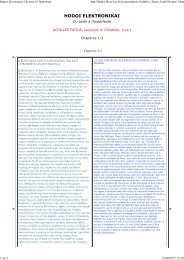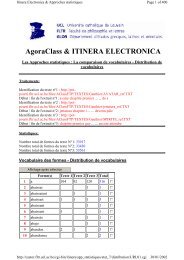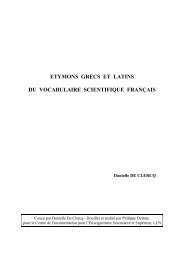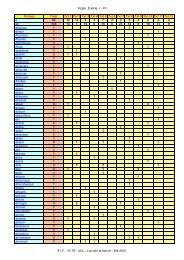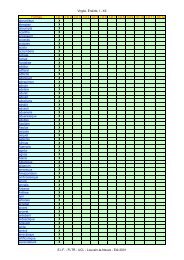The Etymologies of Isidore of Seville - Pot-pourri
The Etymologies of Isidore of Seville - Pot-pourri
The Etymologies of Isidore of Seville - Pot-pourri
Create successful ePaper yourself
Turn your PDF publications into a flip-book with our unique Google optimized e-Paper software.
272 XIII.iii.1–v.6 <strong>Isidore</strong> <strong>of</strong> <strong>Seville</strong><br />
<strong>The</strong>refore an atom iswhatevercannotbedivided,likea<br />
point ingeometry, for means “division” in Greek,<br />
and means “non-division.”<br />
iii. Elements (De elementis) 1.<strong>The</strong>Greekscall the primary<br />
material <strong>of</strong> things (“matter,” also “wood,<br />
woodland”), which is not formed in any way, but is capable<br />
<strong>of</strong> underlying all bodily forms; from this material the<br />
visible elements (elementum) areformed,whence they<br />
took their name from this derivation. 2 Latin speakers<br />
have named this ‘matter’ (materia, also meaning<br />
“wood”) because every unformed substance, <strong>of</strong> which<br />
something is made, is always called matter. Whence the<br />
poets have named it silva (lit. “woodland”), not inappropriately,<br />
because materia is connected with woods. 2.<strong>The</strong><br />
Greeks name the elements ,because they agree<br />
with each other in a certain accord and communion <strong>of</strong><br />
association (cf. ,“agreewith”). Indeed, they are<br />
said to be joined thus among themselves with a certain<br />
natural logic, now returningtotheirorigin,fromfireto<br />
earth, now from earth to fire, since fire ends in air, and air<br />
is condensed into water, and water thickens into earth;<br />
and in turn, earth is loosened into water, water rarefied<br />
into air, and air thinned out into fire. 3.For this reason,<br />
all the elements are present in all, but each one has taken<br />
its name from whichever element is more abundant in it.<br />
<strong>The</strong> elements are assigned by Divine Providence to the<br />
appropriate living beings, for the Creator himself has<br />
filled heaven (i.e. the fiery realm) with angels, air with<br />
birds, water with fish, and earth with humans and the<br />
rest <strong>of</strong> the living things.<br />
iv. <strong>The</strong> sky (De caelo) 1.<strong>The</strong>sky (caelum) 3 is so named<br />
because, like an engraved (caelatum) vessel, it has the<br />
lights <strong>of</strong> the stars pressed into it, just like engraved<br />
figures; for a vessel which glitters with figures that stand<br />
out is called caelatus. Godembellished the heaven and<br />
filled it with bright light – that is, he adorned it with the<br />
sun and the gleaming orb <strong>of</strong> the moon, and the glorious<br />
constellations <strong>of</strong> glittering stars. [In a different way, it<br />
is named from engraving (caelare)thesuperior bodies.]<br />
2.Itiscalled in Greek, after the term ,<br />
that is, ‘seeing,’ because the air is transparent and clearer<br />
for seeing. In Sacred Scripture the sky is called the firmament<br />
(firmamentum), because it is secured (firmare)by<br />
the course <strong>of</strong> the stars and by fixed and immutable laws.<br />
3. Sometimes the word ‘sky’ is used for the air, where<br />
winds and clouds and storms and whirlwinds arise.<br />
Lucretius (cf. On the Nature <strong>of</strong> Things 4.133):<br />
<strong>The</strong> sky (caelum), which is called air (aer).<br />
And the Psalm (78:2; 103:12, Vulgate) refers to “fowls <strong>of</strong><br />
the sky (caelum),” when it is clear that birds fly in the air;<br />
out <strong>of</strong> habit we also call this air, ‘sky.’ Thus when we ask<br />
whether it is fair or overcast we sometimes say, “How is<br />
the air?” and sometimes “How is the sky?”<br />
v. Parts <strong>of</strong> the sky (De partibus caeli) 1. <strong>The</strong>ether<br />
(aether) isthe place where the stars are, and signifies<br />
that fire which is separated high above from the entire<br />
world. Of course, ether is itself an element, but aethra<br />
(i.e. another word for ether) is the radiance <strong>of</strong> ether;<br />
it is a Greek word. 2. <strong>The</strong>sphere (sphaera) <strong>of</strong>thesky<br />
is so named because it has a round shape in appearance.<br />
But anything <strong>of</strong> such a shape is called a sphaera<br />
by the Greeks from its roundness, such as the balls that<br />
children play with. Now philosophers say that the sky<br />
is completely convex, in the shape <strong>of</strong> a sphere, equal<br />
on every side, enclosing the earth, poised in the center<br />
<strong>of</strong> the world’s mass. People say that the sky moves,<br />
and with its motion the stars fixed in it go around from<br />
east to west, with the stars <strong>of</strong> the Big Dipper proceeding<br />
around the pole in shorter rotations. 3.<strong>The</strong> axis (axis)is<br />
astraightlinefromtheNorth that extends through the<br />
center ball <strong>of</strong> the sphere, and it is called ‘axis’ because<br />
around it the sphere turns like a wheel, or because the<br />
Wain (i.e. ‘wagon,’ another name for the Big Dipper)<br />
is there. 4. <strong>The</strong> poles are the ends <strong>of</strong> the axis, and they<br />
are called poles (cardo, lit. ‘pivot’) because the sky turns<br />
around them. 5. <strong>The</strong>re are circular polar regions that<br />
runaround the axis. One <strong>of</strong> them is the northern, which<br />
never sets, and is called ‘Boreus,’ the other is the southern,<br />
which is never visible, and is called ‘Austronotius.’<br />
And theyarecalled‘polar regions’ (polus), because they<br />
are circles around the axis (i.e. “axle”), after the usage<br />
<strong>of</strong> a wagon, named specifically from ‘polishing’ (polire).<br />
But the Boreus polar region is always visible, and the<br />
Austronotius never, because the right side <strong>of</strong> the heavens<br />
is higher and the southern side is pressed down.<br />
6.<strong>The</strong> vaults (convexum)are the edges <strong>of</strong> the sky, named<br />
from their curvature, for a convex (convexus) thing is<br />
2 <strong>Isidore</strong> is linking the words and elementum by sound.<br />
3 See footnote 1 above.








